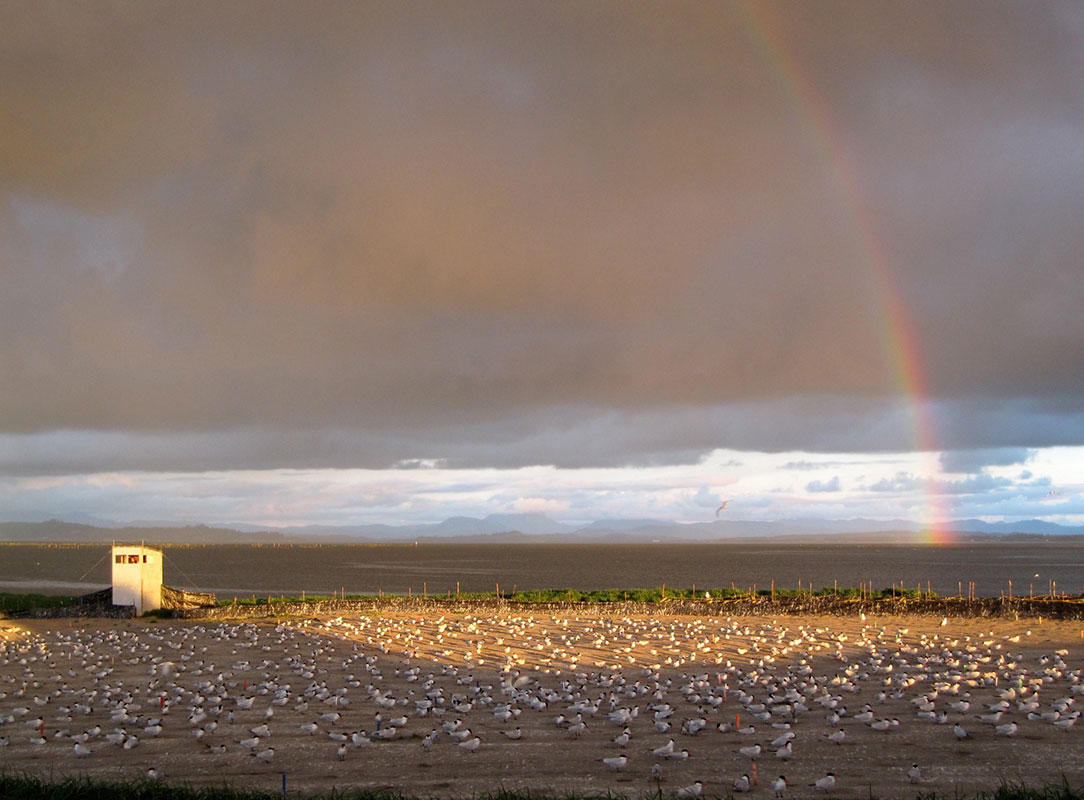 2015 Final Annual Report
2015 Final Annual Report
The primary objective of this study in 2015 was to monitor and evaluate management initiatives implemented to reduce predation on juvenile salmonids (Oncorhynchus spp.) by Caspian terns (Hydroprogne caspia) nesting on East Sand Island in the Columbia River estuary. Specifically, we monitored and evaluated the managed reduction of tern nesting habitat on East Sand Island, which is designed to reduce the size of the Caspian tern breeding colony and, as a consequence, reduce tern predation on ESA-listed juvenile salmonids in the Columbia River estuary.
The management plan entitled, Caspian Tern Management to Reduce Predation of Juvenile Salmonids in the Columbia River Estuary was first implemented in 2008, and implementation continued in 2015. As part of this plan, the U.S. Army Corps of Engineers – Portland District (Corps) provided 1.0 acre of suitable nesting habitat for Caspian terns on East Sand Island prior to the 2015 nesting season, a reduction in the area of nesting habitat provided in 2014 (1.55 acres), and a 80% reduction in what was provided for terns on East Sand Island prior to implementation of the management plan. The estimate of Caspian tern colony size on the 1.0-acre core colony area in 2015 was 5,430 breeding pairs (95% c.i. = 5,200 – 5,660 pairs), about 13% smaller than in 2014 (6,270 breeding pairs; 95% c.i. = 5,860 – 6,680 pairs), and nearly a 50% reduction from the peak size of the tern colony on East Sand Island (ca. 10,670 pairs), which occurred in 2008. Despite efforts to limit tern nesting on East Sand Island to the 1.0-acre core colony area using passive dissuasion (stakes, rope, and flagging) and active dissuasion (human hazing), two satellite colonies formed adjacent to the core colony area and supported an additional 810 breeding pairs. As a result, the total number of Caspian terns nesting on East Sand Island in 2015 (6,240 pairs; 95% c.i. = 6,000 – 6,460 pairs) was about the same as the colony size in 2014 (6,270 pairs), despite the reduction in amount of nesting habitat prepared for terns in 2015 relative to the previous year. Additionally, some Caspian terns attempted to nest on Rice Island in 2015, a dredged material disposal island in the upper Columbia River estuary, where Caspian terns nested prior to relocating the colony to East Sand Island in 2001.
In 2015, the average nesting density of Caspian terns in the 1-acre core colony area on East Sand Island was 1.32 nests/m2, an increase from the average nesting density of terns on East Sand Island in 2014 (1.06 nests/m2), and the highest nesting density ever recorded for Caspian terns nesting on East Sand Island. Given the more than 30-year history of Caspian terns nesting in the Columbia River estuary, it is expected that some, perhaps most, terns will initially adapt to reductions in the amount of suitable nesting habitat on East Sand Island by nesting at higher densities and/or attempting to nest in other, sometimes marginal, nesting habitat on East Sand Island (e.g., upland beaches) and elsewhere in the Columbia River estuary (e.g., Rice Island). Efforts to reduce Caspian tern predation on juvenile salmonids to levels stipulated in the management plan will likely require that all Caspian terns nesting in the Columbia River estuary be restricted to just the 1-acre core colony area on East Sand Island, thereby forcing terns displaced from East Sand Island to relocate to alternative colony sites outside the Columbia River Basin.
Caspian terns nesting on East Sand Island in 2015 were relatively resilient to disturbances by bald eagles (Haliaeetus leucocephalus) and associated gull (Larus spp.) depredation of tern eggs and chicks, even more so than was the case during 2013-2014. These limiting factors caused the Caspian tern colony on East Sand Island to fail or nearly fail during 2010-2012. In 2015, the East Sand Island Caspian tern colony produced about 3,700 fledglings (average of 0.59 young raised/breeding pair), an increase compared to 2014 (0.28 young raised/breeding pair), and similar to the average productivity during 2000-2014 (0.57 young raised/breeding pair).
To assess the efficacy of management implemented to disperse Caspian terns from nest sites within the Columbia River Basin to alternative colony sites outside the Basin, we monitored Caspian tern movements by re-sighting terns previously banded with field-readable leg bands at colonies both inside and outside the Basin. The majority of resighted Caspian terns exhibited site fidelity to the colony on East Sand Island in 2015. There was little movement of Caspian terns banded as adults on East Sand Island to the Corps-constructed alternative colony sites in interior Oregon and northeastern California in 2015; nevertheless, Caspian terns banded as chicks at East Sand Island were observed at all four of the monitored alternative colony sites in 2015. Estimated numbers of Caspian terns that moved from the alternative colony sites to the Columbia River estuary and to the Columbia Plateau region in 2015 were greater than those that moved in the opposite directions, probably due to the severe drought that has negatively affected tern nesting and foraging habitat in interior Oregon and northeastern California during 2014-2015.
The average proportion of juvenile salmonids in the diet of Caspian terns nesting on East Sand Island during the 2015 nesting season was 38% (percent of identified prey items), higher than the average during the previous 15 years (31%), and corresponding to a somewhat lower than average proportion of northern anchovy (Engraulis mordax) in the tern diet. The estimated total smolt consumption by Caspian terns nesting at East Sand Island in 2015 was 5.2 million smolts (95% c.i. = 4.6 – 5.9 million smolts), not significantly different from the average annual smolt consumption during 2000–2014, but significantly lower than annual smolt consumption when the Caspian tern colony was located on Rice Island in the upper estuary. Consumption of sub-yearling Chinook salmon by East Sand Island Caspian terns in June and July was significantly higher in 2015 than in 2014, presumably due to reduced availability of alternative prey such as northern anchovy.
To further reduce predation rates by Caspian terns nesting at East Sand Island on salmonid smolts in the Columbia River estuary, more Caspian terns will need to be relocated to colonies outside the estuary. Based on the size of the East Sand Island colony in 2015 (6,240 breeding pairs) relative to the target colony size stipulated in the Management Plan (3,125 - 4,375 breeding pairs), an additional 1,900-3,100 breeding pairs will need to be relocated outside the estuary. This will likely require an increased effort to prevent Caspian terns from nesting outside the designated 1-acre core colony area on East Sand Island. In addition, either nesting density within the 1-acre core colony area on East Sand Island will need to decline from the record density observed in 2015 or the core colony area will need to be reduced to less than 1 acre of nesting habitat, or both, in order to meet the management goal for colony size stipulated in the Plan.
-Bird Research Northwest
Click here to see full report



